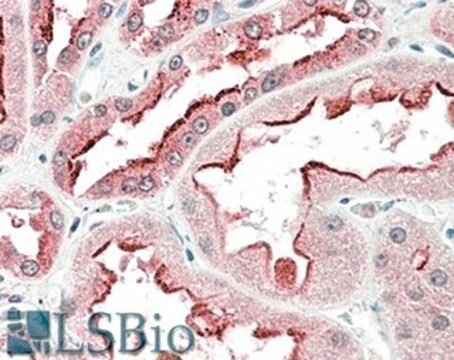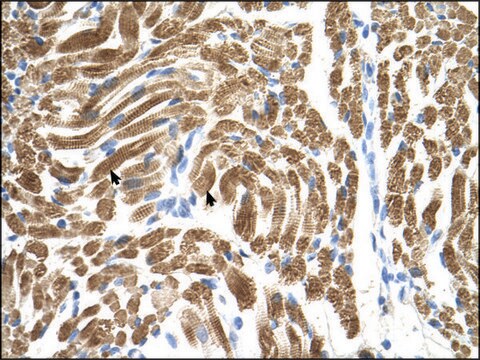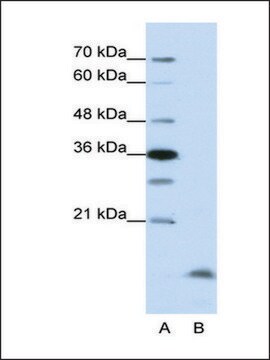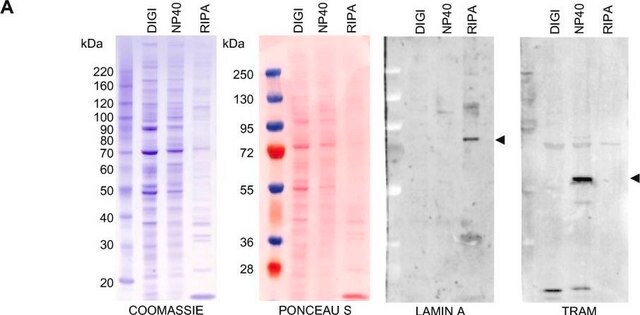General description
CD40 ligand, a membrane glycoprotein, is a member of the TNF family. It is predominantly expressed on activated CD4+ T cells, as well as on other cell types. The receptor to CD40 ligand is CD40. The binding of CD40 and CD40 ligand mediates B cell, monocyte, and dendritic cell activities. CD40 (BP50), a 48 kDa type I single chain transmembrane glycoprotein expressed on normal and neoplastic B cells, but not on terminally differentiated plasma cells. CD40 antigen is also present on Hodgkin′s and Reed-Sternberg cells, follicular dendritic cells, some macrophages, basal epithelial cells and endothelial cells.
Specificity
Anti-CD40 polyclonal antibody reacts with human CD40 molecule.
Immunogen
Synthetic peptide directed towards the N terminal region of human CD40
Application
Anti-CD40 polyclonal antibody is used to tag CD40 proteins for detection and quantitation by Western blotting and in cells and tissues by immunohistochemical (IHC) techniques. It is used as a probe to study the role of CD40 in cell signaling within T-cells, dendritic cells, macrophages, epithelial and endothelial cells.
Biochem/physiol Actions
CD40 is a member of the TNF-receptor superfamily. This receptor has been found to be essential in mediating a broad variety of immune and inflammatory responses including T cell-dependent immunoglobulin class switching, memory B cell development, and germinal center formation. AT-hook transcription factor AKNA is reported to coordinately regulate the expression of this receptor and its ligand, which may be important for homotypic cell interactions. Adaptor protein TNFR2 interacts with this receptor and serves as a mediator of the signal transduction. The interaction of this receptor and its ligand is found to be necessary for amyloid-beta-induced microglial activation, and thus is thought to be an early event in Alzheimer disease pathogenesis.The protein encoded by this gene is a member of the TNF-receptor superfamily. This receptor has been found to be essential in mediating a broad variety of immune and inflammatory responses including T cell-dependent immunoglobulin class switching, memory B cell development, and germinal center formation. AT-hook transcription factor AKNA is reported to coordinately regulate the expression of this receptor and its ligand, which may be important for homotypic cell interactions. Adaptor protein TNFR2 interacts with this receptor and serves as a mediator of the signal transduction. The interaction of this receptor and its ligand is found to be necessary for amyloid-beta-induced microglial activation, and thus is thought to be an early event in Alzheimer disease pathogenesis. Two alternatively spliced transcript variants of this gene encoding distinct isoforms have been reported.
Sequence
Synthetic peptide located within the following region: WNRETHCHQHKYCDPNLGLRVQQKGTSETDTICTCEEGWHCTSEACESCV
Physical form
Purified antibody supplied in 1x PBS buffer with 0.09% (w/v) sodium azide and 2% sucrose.
Disclaimer
Unless otherwise stated in our catalog or other company documentation accompanying the product(s), our products are intended for research use only and are not to be used for any other purpose, which includes but is not limited to, unauthorized commercial uses, in vitro diagnostic uses, ex vivo or in vivo therapeutic uses or any type of consumption or application to humans or animals.









